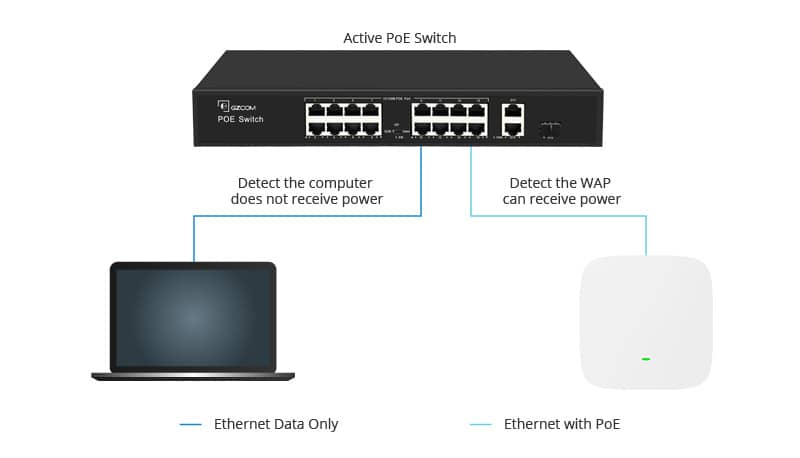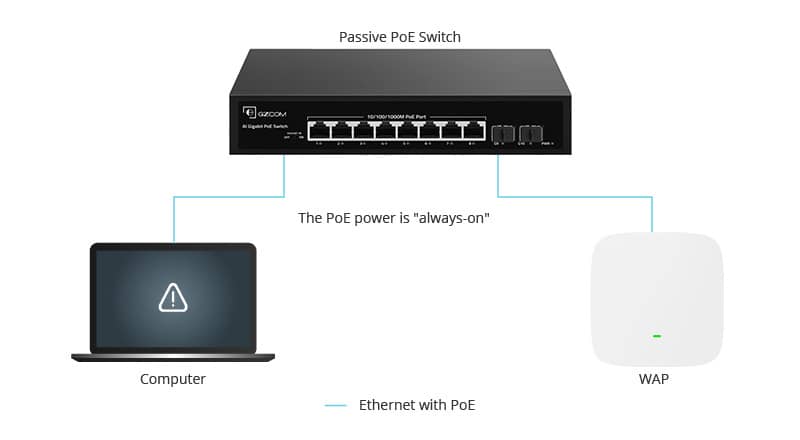Please submit your message online and we will contact you as soon as possible!
- Experience security and speed, without compromise.

2024-06-14
PoE Switch are essential for providing both network connectivity and power to devices like IP phones, IP cameras, and access points using a single Ethernet cable. As these devices become more common in enterprise and campus networks, choosing the right PoE switch is crucial for reducing deployment complexity and cost. This article will explain the differences between active and passive PoE switches and help you determine which type is best suited for your network.
Active PoE, also known as standard PoE, refers to any PoE system that negotiates the proper voltage between the power supply equipment (PSE) and the powered device (PD). An active PoE switch adheres to IEEE standards such as IEEE 802.3af, IEEE 802.3at, or IEEE 802.3bt. These switches, which can be classified into PoE, PoE+, and PoE++ (differences between PoE, PoE+, and PoE++ )categories, perform a negotiation process before supplying power to ensure compatibility, thereby preventing potential damage to non-PoE devices.

Passive PoE, or non-standard PoE, delivers power over Ethernet lines without any negotiation or communication process. A passive PoE switch does not comply with IEEE standards and continuously sends a fixed voltage over the Ethernet cable, regardless of the receiving device's power requirements. This can pose a risk of burning out devices that are not designed to handle PoE.

Active and passive PoE switches both provide PoE connections but differ significantly in several aspects:
1.PoE Power Supply Pinout
● Active PoE Switches: Support PoE Mode A, PoE Mode B, and 4-pair PoE, delivering power through different sets of pins.
● Passive PoE Switches: Typically support only PoE Mode B.
2.Ethernet Support
● Active PoE Switches: Support 10/100/1000Mbps Ethernet up to 100m over Cat5/5e/6 cables, making them suitable for both traditional and modern networks.
● Passive PoE Switches: Generally support only 10/100Mbps Ethernet up to 100m.
3.Cost
● Active PoE Switches: More expensive due to built-in PoE power controllers that perform device detection and classification.
● Passive PoE Switches: Less expensive as they lack these components.
4.Safety
● Active PoE Switches: High safety due to power negotiation.
● Passive PoE Switches: Lower safety; continuous power supply can damage non-PoE devices.
5.Power Injection
● Active PoE Switches: Provide power after negotiation.
● Passive PoE Switches: Provide power immediately without negotiation.
| Feature | Active PoE Switch | Passive PoE Switch |
|---|---|---|
| Standard | IEEE 802.3af/at/bt | N/A |
| Power Injection | After Negotiation | Immediately |
| Power Supply Mode | Mode A/B/4-Pair PoE | Mode B |
| Ethernet Support | 10/100/1000BASE-T | 10/100BASE-T |
| Max. Distance | 100m | 100m |
| Safety | High | Low |
| Cost | Medium | Low |
For most scenarios, especially where safety and device compatibility are concerns, an active PoE switch is the recommended choice. Active PoE switches ensure that only compatible devices receive power, reducing the risk of damage and enhancing network reliability.
However, if budget constraints are a primary concern, a passive PoE switch may be considered. In such cases, it is crucial to ensure that the passive PoE switch's power specifications match the requirements of the devices being powered to avoid potential damage. Additionally, avoid connecting non-PoE devices, such as computers, to passive PoE switches.
Please submit your message online and we will contact you as soon as possible!